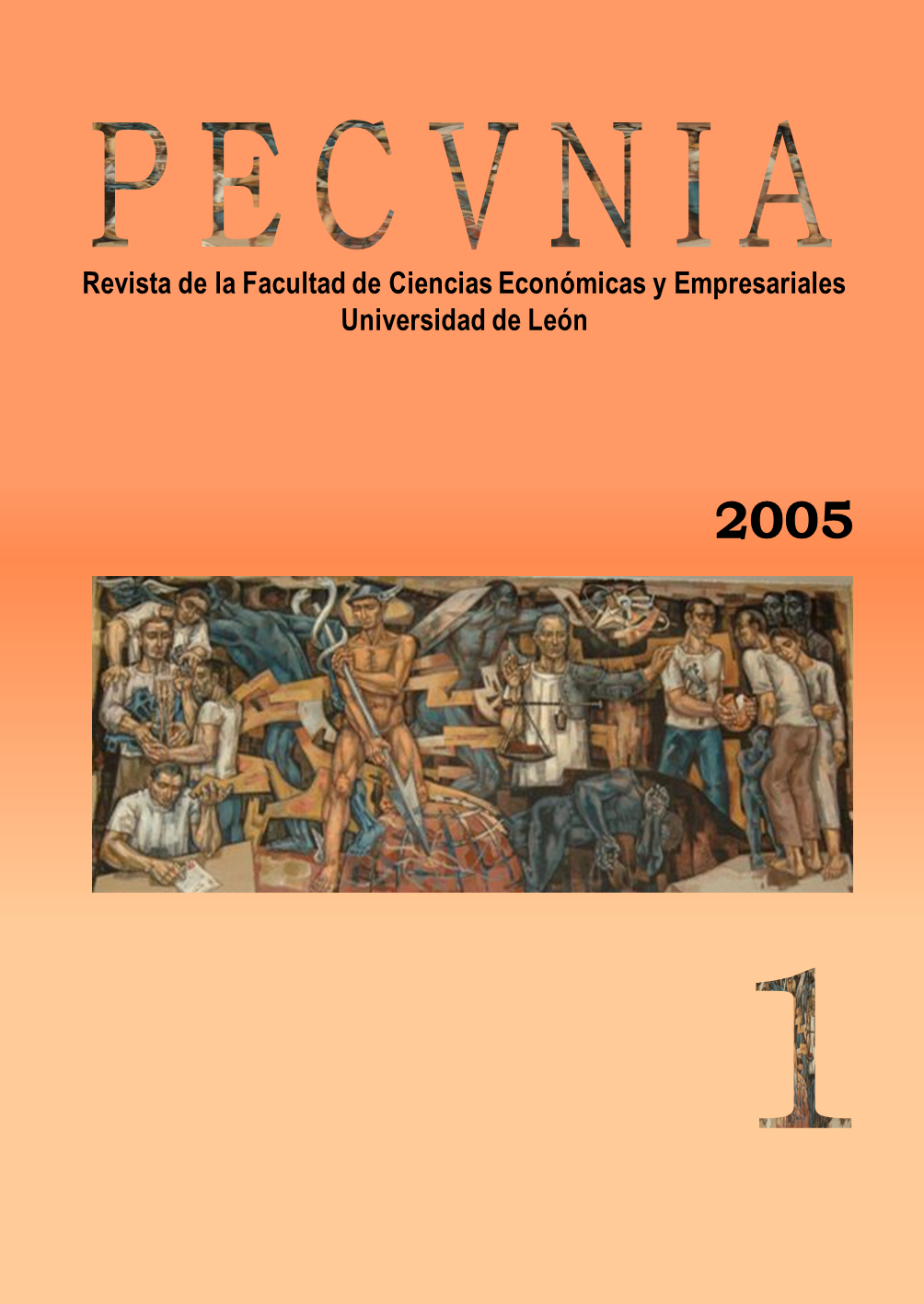Naturaleza y significado de los libros de cuentas de John Isham, mercader de Isabel I, Reina de Inglaterra
DOI:
https://doi.org/10.18002/pec.v0i1.745Palabras clave:
Libros mayores, Teneduría de libros, Partida doble, Dinastía Tudor, Ledgers, Bookkeeping, Double entry, Tudor dinastyResumen
De todos los libros de cuentas de John Isham tan sólo se conservan dos Libros Mayores. Representan el esfuerzo continuado, durante un intervalo de doce años, para confeccionar un balance de situación. Es indudable que John Isham se había familiarizado con los rudimentos del arte de la teneduría de libros durante su periodo de aprendiz, bajo la supervisión de su patrón, probablemente en Amberes. El uso que hace de la partida doble, aunque sólo ocupa una pequeña parte del primer Libro Mayor y ninguna del segundo, indica que apostaba por el progreso.El valor de estos dos Libros Mayores del siglo XVI es grande, pues nos dice mucho de la estructura de la exportación de paños, usos que un mercader mediano hace de su capital y otros aspectos dfíciles de averiguar por otras vías. En ambos volúmenes las partidas recogen multitud de detalles que nos hablan del entramado del comercio internacional inglés en el floreciente reinado de Isabel I. Al lado de la parida dole aparecen las compañías gremiales que concedieron al comercio inglés la fueza y el esplendor sobre los que se asentó el Imperio Británico.Out of all the account books of John Isham, only two ledgers are preserved at present. They represent a constant effort, for a twelve-year interval, in order to produce a balance sheet. John Isham, no doubt, had learnt the technicalities of the art of bookkeeping duritng his appenticeship period, under his master's supervision, probably in Antwerp. His use of the double entry system, despite it si only present in some sections of the first ledger and none of the second, it is a clear indication that he favoured progress.The value of these two ledgers is remarkable. They talk about the structure of cloth exportation, how a medium-sized merchant used his capital and some other aspects which are difficult to find out through other means. In both volumes entries release multiple details which tell us about the international English commerce during Queen Elizabeth's flourishing period. Together with the double entry system, merchants' companies yielded the English comerce strength and splendour upon which the British Empire was built.
Descargas
Citas
BAKER, George (1822-1830) The History and Antiquities of the Country of Northampton. London: John Bowyer Nichols and Son.
BISSON, Douglas R. (1993) The Merchant Adventurers of England: The Company and the Crown. University of Delaware Press.
BRIDGES, John (1791) The History and Antiquities of Northamptonshire, 2 vols., Compiled from the Manuscript Collections of the Late Learned Antiquary John Bridges, Esq., by the Rev. Peter Whalley, Late Fellow of St. John's College, Oxford. Oxford: D. Prince and J. Cooke.
BRIQUET, C.M. (1923) Les Filigranes. Dictionnaire historique des marques du papier dès leur apparition vers 1282 jusqu'en 1600. Leipzig: Verlag von Karl W. Hiersemann. Calendar of the Patent Rolls Preserved in the Public Record Office, Elizabeth, 1560-1563. London: His Majesty Stationery Office, 1948.
Calendar of Patent Rolls Preserved in the Public Record Office, Philip and Mary, 1554-1555. London: His Majesty's Stationery Office, 1936.
CONNELL-SMITH, G. (1950-1) "The Ledger of Thomas Howell", Economic History Review, Second series, III, pp. 363-70.
EDLER, Florence (1934) Glossary of Mediaeval Terms of Business. Italian Series, 1200-1600. Cambridge, Mass.: The Mediaeval Academy of America.
FINCH, Mary E. (1956) The Wealth of Five Northamptonshire Families, 1540-1640. Oxford: Northamptonshire Record Society, Oxford University Press.
FISHER, F.J. (1939-40) "Commercial Trends and Policy in Sixteenth-Century England", The Economic History Review, X, pp. 95-117.
HEERS, Jacques (1959) Le livre de comptes de Giovanni Piccamiglio, homme d'affaires génois, 1456-1459. Paris: S.E.V.P.E.N.
HOLDSWORTH, W.S. (1945) A History of English Law, 7 vols. London: Methuen & Co., Ltd.
HORTON-SMITH, L.G.H. (1948) The Ancient Northern Family of Lumley and Its Northamptonshire Branch. Record of the Past 680 Years. St. Albans: The Campfield Press.
LONGDEN, Henry Isham (1940) Northamptonshire and Rutland Clergy from 1500. London: Archer & Goodman.
LYELL, Laetitia (1934-1935) "The Problem of the Records of the Merchant Adventurers", The Economic History Review, V.
METCALFE, Walter C. (1878) The Visitations of Essex. London: The Harleian Society.
PEELE, James (1553) The maner and fourme how to kepe a perfecte reconyng after the order of the moste worthie and notable accompte of Debitour and Creditour... Imprinted at London, by Richard Grafton.
PEILE, J. (1910) Biographical Register of Christ's college, 1505-1905, and of the Earlier Foundation, God's House, 1448-1505, 2 vols. Cambridge University Press.
RAMSEY, G.D. (1962) John Isham, Mercer and Merchant Adventurer. Two Account Books of a London Merchant in the Reign of Elizabeth I, Gateshead. Co. Durham: Northamptonshire Record Society, Northumberland Press Limited.
RAMSEY, G.D. (1986) The Queen's Merchants and the Revolt of the Netherlands. Manchester University Press.
RAMSEY, P.H. (1956) "Some Tudor Merchants' Accounts", Studies in the History of Accounting. Ed. A.C. Littleton and B.S. Yamey. London: Sweet & Maxwell, pp. 185-201.
Register of Admissions to the Honourable Society of the Middle Temple from the Fifteenth Century to Year 1944. London: Butterwworth & Co. (Publishers) Ltd., 1944.
ROOVER, Florence Edler de (1952) "Cost Accounting in the Sixteenth Century", Studies in Costing, Ed. David Solomons. London: Sweet & Maxwell, Limited, pp. 53-71.
ROOVER, R. De (1937) "Aux origines d'une technique intellectuelle: la formation et l'expansion de la comptabilité à parti-double", Annales, IX.
ROOVER, R. De (1955) "New Perspectives on the History of Accounting", Accounting Review, XXX, pp. 405-20.
SIMPSON, Alan (1961) The Wealth of the Gentry, 1540-1660. Cambridge University Press.
THOMSON, Gladys Scott (1949) Family Background. London: Jonathan Cape.
THOMSON, H.W. and B.S. Yamey (1958) "Bibliography of Bookkeeping and Accounts – 1494 to 1640", Accounting Research, IX, pp. 239-44.
WATERS, Robert Edmond Chester (1878) Genealogical Memoirs of the Extinct Family of Chester of Chicheley, Their Ancestors and Descendants, 2 vols. London: Robson and Sons, vol. I.
WEDDINGTON, John (1567) A breffe instruction, and manner, howe to kepe, marchantes bokes, of accomptes. After the order of Debitor and Creditor... Preenttyd in Andvvarpe, by Petter van Keeberghen.
WILLAN, T.S. (1953) The Muscovy Merchants of 1555. Manchester University Press.
YAMEY, B.S. (1949) "Scientific Bookkeeping and the Rise of Capitalism", Economic History Review, 2nd. Series, I, pp. 99-113.
Descargas
Publicado
Cómo citar
Número
Sección
Licencia
Derechos de autor 2005 Juan Lanero Fernández, Eduardo Ortega Montes

Esta obra está bajo una licencia internacional Creative Commons Atribución-NoComercial-CompartirIgual 4.0.
Los autores que publican en esta revista están de acuerdo con los siguientes términos:- Los autores ceden de forma no exclusiva los derechos de explotación (reproducción, distribución, comunicación pública, transformación) a la Universidad de León, por lo que pueden establecer, por separado, acuerdos adicionales para la distribución no exclusiva de la versión de la obra publicada en la revista (por ejemplo, alojarlo en un repositorio institucional o publicarlo en un libro), con un reconocimiento de su publicación inicial en esta revista.
- Este trabajo se encuentra bajo la Creative Commons Attribution-NonCommercial-ShareAlike 4.0 International License. Puede consultarse desde aquí la versión informativa y el texto legal de la licencia.
- Se permite y se anima a los autores a difundir electrónicamente las versiones pre-print (versión antes de ser evaluada) y/o post-print (versión evaluada y aceptada para su publicación) de sus obras antes de su publicación, ya que favorece su circulación y difusión más temprana y con ello un posible aumento en su citación y alcance entre la comunidad académica.












